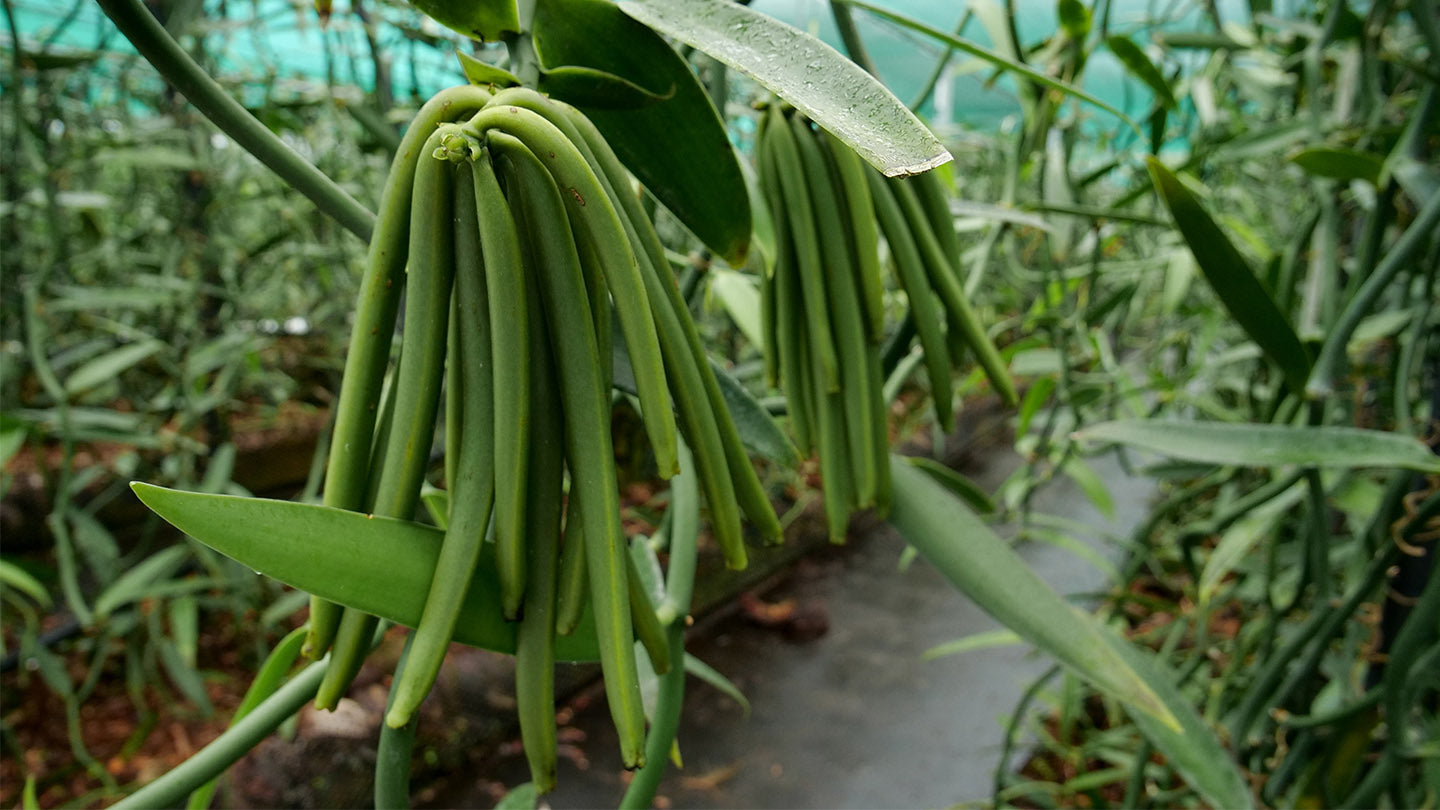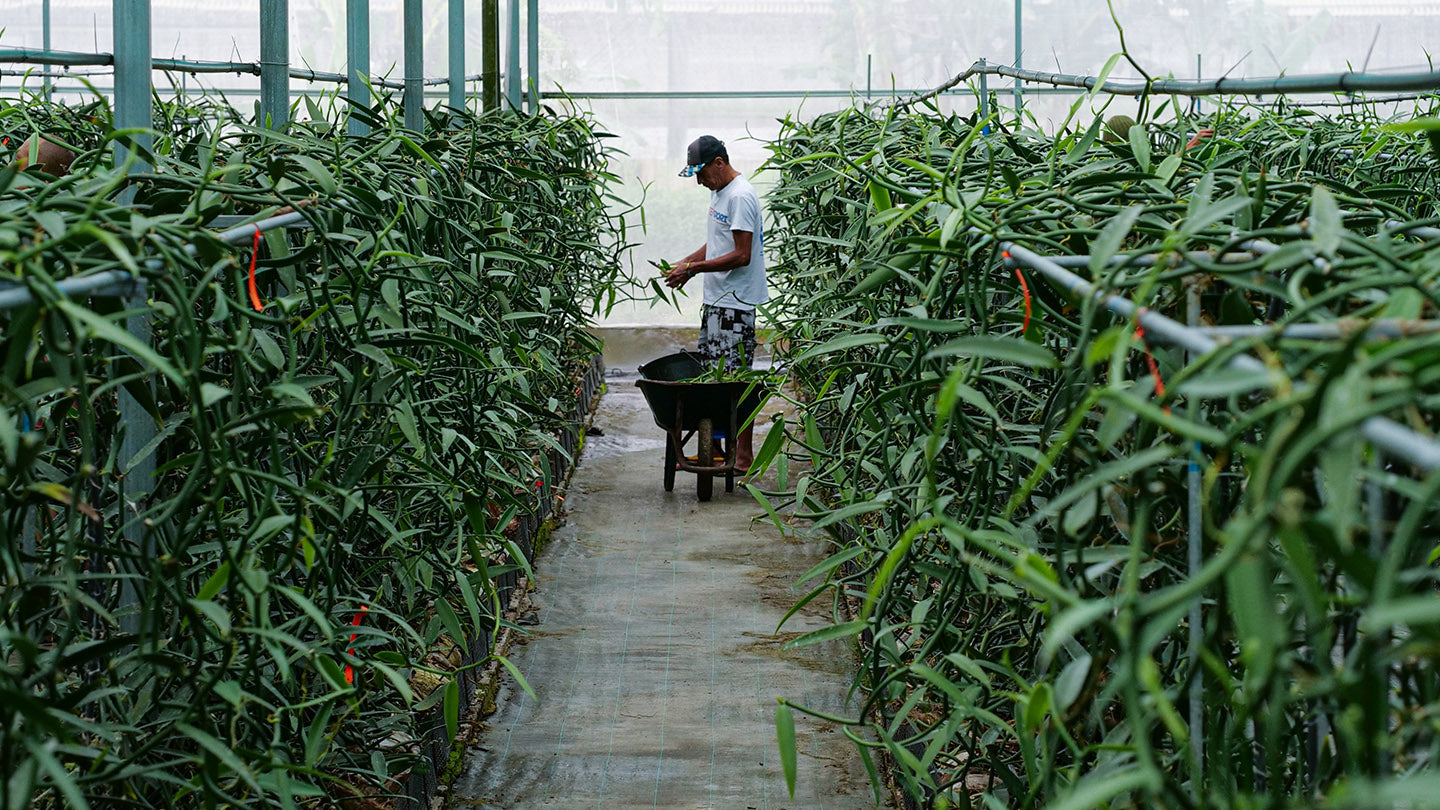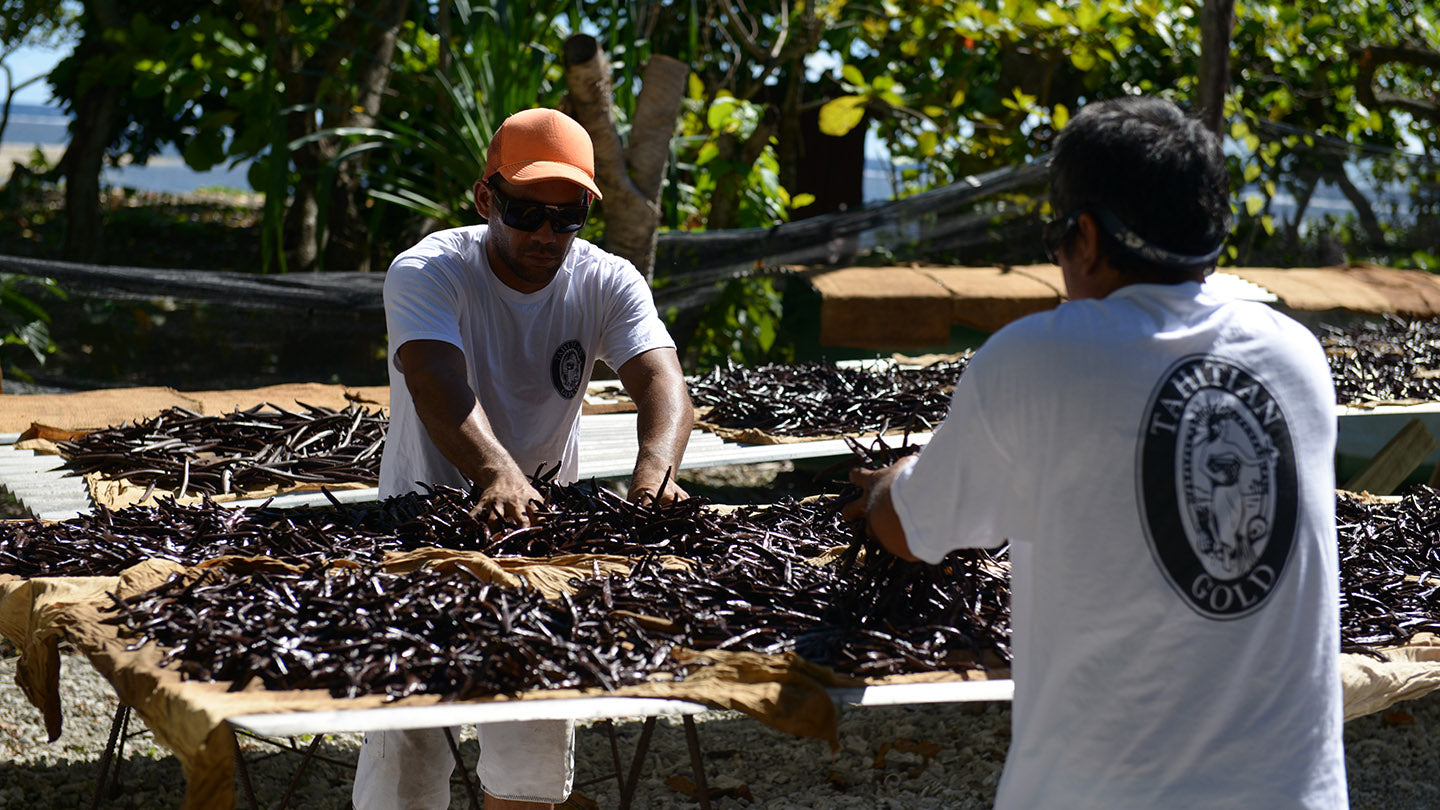01.08.2020
A Taste of Paradise: Tahitian Vanilla Beans
Learn what makes Tahitian vanilla unique, how it is grown and cured, and simple tips for using and storing these fragrant beans.
- Tahitian vanilla is a distinct hybrid with a floral, fruity profile and lower vanillin but higher compounds like coumarin.
- Plants are hand-pollinated, beans mature for about nine months, then undergo an intensive sun-and-sweat curing up to six months.
- Use scraped seeds for batters, custards and sauces; use pods to infuse sugar or spirits. Pairs well with both sweet and savory dishes.

Few flavors are as complex as true vanilla. The Tahitian variety is no exception, delivering a delicately floral and fruity aroma with distinct notes of black cherry and tart plum. The world’s choosiest pastry chefs prefer Tahitian vanilla for its exotic flavor, juicier pod, and high seed content.  This nuanced flavor profile pairs well with a variety of both sweet and savory recipes. Cakes, puddings, and ice cream are obvious canvases for this spice, but even barbecue sauce, grilled fish, roasted duck, and tomato sauce improve with some added vanilla. Since this spice is rare and luxurious, we recommend using it in recipes where there are few competing flavors.
This nuanced flavor profile pairs well with a variety of both sweet and savory recipes. Cakes, puddings, and ice cream are obvious canvases for this spice, but even barbecue sauce, grilled fish, roasted duck, and tomato sauce improve with some added vanilla. Since this spice is rare and luxurious, we recommend using it in recipes where there are few competing flavors.
What Makes Tahitian Vanilla So Special?
Tahitian vanilla’s flavor is noticeably different than its counterparts. Sharp, fruity, and sweet, this is not the same vanilla many of us grew up with. Mexican vanilla and Madagascar vanilla taste and smell similarly sweet and buttery due to the high presence of vanillin—the chemical compound that gives vanilla its distinct flavor. There are, however, hundreds of other important flavor compounds found in vanilla that form its overall profile. Tahitian vanilla actually has a lower vanillin content than Mexican and Madagascar beans, but maintains greater levels of other flavor compounds. Higher levels of the flavor compound coumarin help give Tahitian vanilla its fruitier flavor. This is the same compound found principally in strawberries, black currants, apricots, and cherries.
 Although vanilla is native to Mexico—originally cultivated by Totonac and Aztec peoples—it has flourished in Tahiti’s tropical climate and volcanic soil for more than 170 years. Vanilla is a member of the orchidaceae family, and the only orchid cultivated for non-ornamental purposes. Tahitian vanilla is recognized as its own species. DNA sequencing confirms that Vanilla tahitensis is a cross between Vanilla planifolia and Vanilla odorata. (V. planifolia is the most-cultivated species in the world, grown predominantly in Mexico and Madagascar. V. odorata is a rare species believed only to exist in the wild.)
Although vanilla is native to Mexico—originally cultivated by Totonac and Aztec peoples—it has flourished in Tahiti’s tropical climate and volcanic soil for more than 170 years. Vanilla is a member of the orchidaceae family, and the only orchid cultivated for non-ornamental purposes. Tahitian vanilla is recognized as its own species. DNA sequencing confirms that Vanilla tahitensis is a cross between Vanilla planifolia and Vanilla odorata. (V. planifolia is the most-cultivated species in the world, grown predominantly in Mexico and Madagascar. V. odorata is a rare species believed only to exist in the wild.)
How is Tahitian Vanilla Grown and Cured?
An hour’s drive east of Tahiti’s capital city of Pape'ete, spindly, green vines bearing lance-shaped leaves produce the coveted spice. This is the Tahitian Gold vanilla plantation, The Spice House’s exclusive source for Tahitian vanilla. The company is run by the Martin family—third generation vanilla growers who can trace their family’s Tahitian roots back 300 years.
Vanilla grown outside of Mexico and South America must be hand-pollinated since there are no naturally occurring pollinators. The orchid blooms once a year and the blossom is only open for a few short hours in the morning. Workers use a stick to delicately open the flower and press the male and female parts together. Only then does the precious bean begin to form and undergo a nine-month maturation period before moving on to the careful curing process, which can take up to another six months.

Curing is where all of vanilla’s flavor is developed. The orchid blossoms and their green beans are odorless. Most vanilla beans are picked green and blanched in hot water before they are cured in the sun. Tahitian vanilla is allowed to fully mature on the vine before it is cured. The Spice House’s Tahitian vanilla beans are cured on a pristine, family-owned island appropriately named Motu Martin. (Motu is the Tahitian word for island.) The island is sunny and free of pollution, making conditions perfect for the curing process.

To cure vanilla, beans are warmed in the sun during the day and are wrapped in cloth to sweat at night. Over time this reduces the moisture content to the perfect levels while building its flavor. Beans are even massaged by hand daily to ensure a bendable consistency and even curing throughout.
How Do I Use a Whole Vanilla Bean?
To use a vanilla bean, slice the bean open lengthwise with a paring knife. Use the spine of the knife to scrape out the black inner seeds, this is what is known as vanilla caviar. You can then add the vanilla caviar to cake batter, cookie dough, frosting, sauces, etc. The scraped out pod has lots of flavor and can be used to infuse a bottle of spirits or be placed into a jar of cane sugar to capture its flavors.
The savory recipe below asks you to combine the vanilla caviar with Italian black truffle oil. This recipe is quite simple, but it makes use of some very aromatic ingredients. The truffle flavor serves as a strong base note, while the vanilla lends finer aromas to the overall flavor profile.

How is Vanilla Used in Tahitian Cuisine?
Manuata Martin, President of Tahitian Gold Company, recalls many of his mother’s recipes including vanilla. Roasted papaya with freshly pressed coconut milk, savory cream sauces for fish dishes, and homemade Poi, a puree dish made from taro root and banana. Nearly every homemade fruit juice at the Martin house was spiced with real vanilla.
“That’s the difference between Tahiti and other vanilla-producing countries. Tahtitans actually cook with their vanilla beans. It has an effect on our demand and supply,” says Manuanta.
10% of the company’s supply is sold locally—a compelling number considering the population of Tahiti is approximately 189,000 people.
Tropical foods pair well with the fruity profile of Tahitian beans. Coconut, sweet potatoes, taro, fish, lobster, and pork are popular foods in Tahitian kitchens to pair with vanilla.
If you have any questions about our Tahitian vanilla or have a favorite way to use it, please let us know in the comments below. You can also email us at spices@thespicehouse.com.
Article by Geoff Marshall, Staff Writer
Frequently Asked Questions
What makes Tahitian vanilla different from other varieties?
Tahitian vanilla is a unique hybrid species with a more floral and fruity aroma, including black cherry and tart plum notes. It contains less vanillin than Mexican or Madagascar beans but higher amounts of other flavor compounds such as coumarin, which gives it its fruitier character.
How is Tahitian vanilla pollinated and grown?
Vanilla vines in Tahiti are hand-pollinated because the natural pollinators are not present. Each orchid flower opens for only a few hours once a year. Workers gently open the flower and press the male and female parts together, then beans mature on the vine for about nine months.
Why does curing matter and how long does it take?
Curing is when vanilla develops its aroma and flavor. After maturation, curing can take up to six months. Beans are warmed in the sun by day, wrapped to sweat at night, and massaged by hand to reduce moisture and build complex flavors.
How do I use a whole Tahitian vanilla bean?
Slice the pod lengthwise, then use the back of a knife to scrape out the tiny black seeds, often called caviar. Add the seeds to batters, custards, sauces or ice cream. The scraped pod can be put into sugar, spirits, or simmered to extract more flavor.
What recipes pair best with Tahitian vanilla?
Tahitian vanilla works in many sweets like cakes, puddings and ice cream, and in savory dishes such as barbecue sauce, grilled fish, roasted duck, and tomato sauce. It also pairs well with tropical ingredients like coconut, taro, sweet potato, lobster and pork. Use it where flavors are not competing.
Why is Tahitian vanilla more expensive and rare?
It is limited by region and labor. Growing requires hand pollination, long on-vine maturation, and a time intensive curing process. Yields are smaller and some harvests are sold locally, which raises cost compared with mass-grown varieties.
How should I store vanilla beans to keep them fresh?
Store beans in an airtight container in a cool, dark place. Do not refrigerate. You can tuck pods into sugar to preserve aroma or store them submerged in alcohol for very long-term storage. Use them within 1 to 2 years for best flavor.
Is Tahitian vanilla the same species as Madagascar vanilla?
No. Tahitian vanilla is Vanilla tahitensis, a hybrid between Vanilla planifolia and Vanilla odorata. Madagascar vanilla is mainly V. planifolia and has a sweeter, more vanillin-driven profile.
What makes Tahitian vanilla different from other varieties?
Tahitian vanilla is a unique hybrid species with a more floral and fruity aroma, including black cherry and tart plum notes. It contains less vanillin than Mexican or Madagascar beans but higher amounts of other flavor compounds such as coumarin, which gives it its fruitier character.
How is Tahitian vanilla pollinated and grown?
Vanilla vines in Tahiti are hand-pollinated because the natural pollinators are not present. Each orchid flower opens for only a few hours once a year. Workers gently open the flower and press the male and female parts together, then beans mature on the vine for about nine months.
Why does curing matter and how long does it take?
Curing is when vanilla develops its aroma and flavor. After maturation, curing can take up to six months. Beans are warmed in the sun by day, wrapped to sweat at night, and massaged by hand to reduce moisture and build complex flavors.
How do I use a whole Tahitian vanilla bean?
Slice the pod lengthwise, then use the back of a knife to scrape out the tiny black seeds, often called caviar. Add the seeds to batters, custards, sauces or ice cream. The scraped pod can be put into sugar, spirits, or simmered to extract more flavor.
What recipes pair best with Tahitian vanilla?
Tahitian vanilla works in many sweets like cakes, puddings and ice cream, and in savory dishes such as barbecue sauce, grilled fish, roasted duck, and tomato sauce. It also pairs well with tropical ingredients like coconut, taro, sweet potato, lobster and pork. Use it where flavors are not competing.
Why is Tahitian vanilla more expensive and rare?
It is limited by region and labor. Growing requires hand pollination, long on-vine maturation, and a time intensive curing process. Yields are smaller and some harvests are sold locally, which raises cost compared with mass-grown varieties.
How should I store vanilla beans to keep them fresh?
Store beans in an airtight container in a cool, dark place. Do not refrigerate. You can tuck pods into sugar to preserve aroma or store them submerged in alcohol for very long-term storage. Use them within 1 to 2 years for best flavor.
Is Tahitian vanilla the same species as Madagascar vanilla?
No. Tahitian vanilla is Vanilla tahitensis, a hybrid between Vanilla planifolia and Vanilla odorata. Madagascar vanilla is mainly V. planifolia and has a sweeter, more vanillin-driven profile.
We just came back from Tahiti and I found your article fascinating! I use Tahitian vanilla when I make rum. It rounds out the flavor of the rum perfectly! Thanks!
I enjoyed your article. I LOVE vanilla and have made my own vanilla (with Madagascar, Mexican and Tahitian beans) for a number of years now.
Years ago I was able to visit Bora Bora and Moorea, where I was introduced to the wonders of Tahitian vanilla. What a delicate, heavenly flavor. For the past 20 years I’ve dreamed of the Tahitian vanilla sauce I had on fish. I would love to discover a recipe that would allow me to make a similar vanilla sauce at home.
Do you know of any such recipes
Thank you.